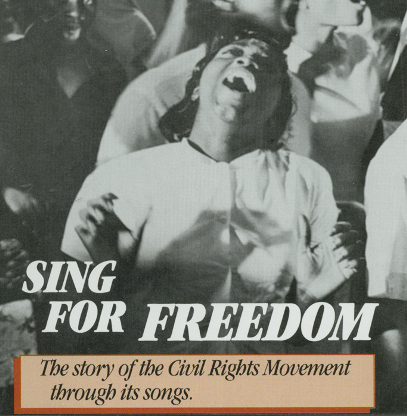
Lesson Hub 1
We Shall Overcome: An Introduction to the Civil Rights Movement
Power to the People! Sounds of the Civil Rights Movement


What do you hear when you think of the
civil rights movement?
We Shall Overcome, by Loïs M. Jones. Smithsonian American Art Museum.


We Shall Overcome: Introduction to the Civil Rights Movement
30-45 MIN
20+ MIN
30+ MIN
Sounds of Civil Rights
Path 1

30–45 minutes

Sitting in class you hear the teacher mention Martin Luther King, Jr.
George Washington, Abraham Lincoln, Martin Luther King Jr., John F. Kennedy -- you've heard them all.
You tune out and doze off...



What's for lunch?
Introduction to the Civil Rights Movement
Bored Girl, by Gerd Altmann. CC0, via Pixabay.


Startled, you awake when the bell rings...
Passing by the window, you notice...
Everything is different.


Introduction to the Civil Rights Movement
Little Boy Reaction at Home, by Fethi Bouhaouchine. CC0, via Pixabay.



Students are wearing:
- Stiffly pressed khaki pants
Introduction to the Civil Rights Movement
- Poodle skirts
- Button-down polo shirt
-
Saddle shoes
Eight of the Nine Black Students Who Have Been Attending Central High School in Little Rock, Ark., Photo by Ferd Kaufman. AP News.



In a panic, you run out of the classroom...
A sign reads:
"Welcome Class of 1955"
You can't find your cell phone!
Is this a joke?
Introduction to the Civil Rights Movement
Panicked Man, by unknown artist, CC By-SA 4.0, via Wikimedia Commons.


It's 1955!
You're the same age you are now and live in the same neighborhood.
Discuss as a class:
What are you wearing?
What do you do for entertainment?
What are the top ten songs?
What are the hot topics?




Introduction to the Civil Rights Movement


"Negro Leaders Arrested in Alabama Bus Boycott!"
"Protests break out in the streets of Montgomery!"
Protestors are singing this song:
You hear news blaring from the radio...
Front Page, February 23, 1963. The New York Times Archive.

Breaking News: The Montgomery Bus Boycott

Rosa Parks refused to give up her seat on the bus to a white man, setting off a boycott of public buses that lasted for 13 months.


Rosa Parks and Journalist Nicholas Chriss Sitting at the Front of a City Bus after Court Ordered Integration, Montgomery, Alabama, December 21, 1956, Unknown Photographer. Library of Congress.
The Montgomery Bus Boycott

The bus boycott launched a movement that continued for over a decade. From across the United States, people gathered in a collective effort to fight for equality for Black Americans . . .

Empty Bus - Montgomery Bus Boycott, by Dan Weiner. National Archives

. . . This was known as the
civil rights movement
The Montgomery Bus Boycott
"Colored"
"Negro"
"Afro-American"
"African-American"
"Black"
"Person of Color"
Labels play an important role in defining groups and individuals in those groups.
The civil rights movement in the 1950s and '60s propelled changes in the labels that identified Americans with roots in continental Africa.


Introduction to the Civil Rights Movement

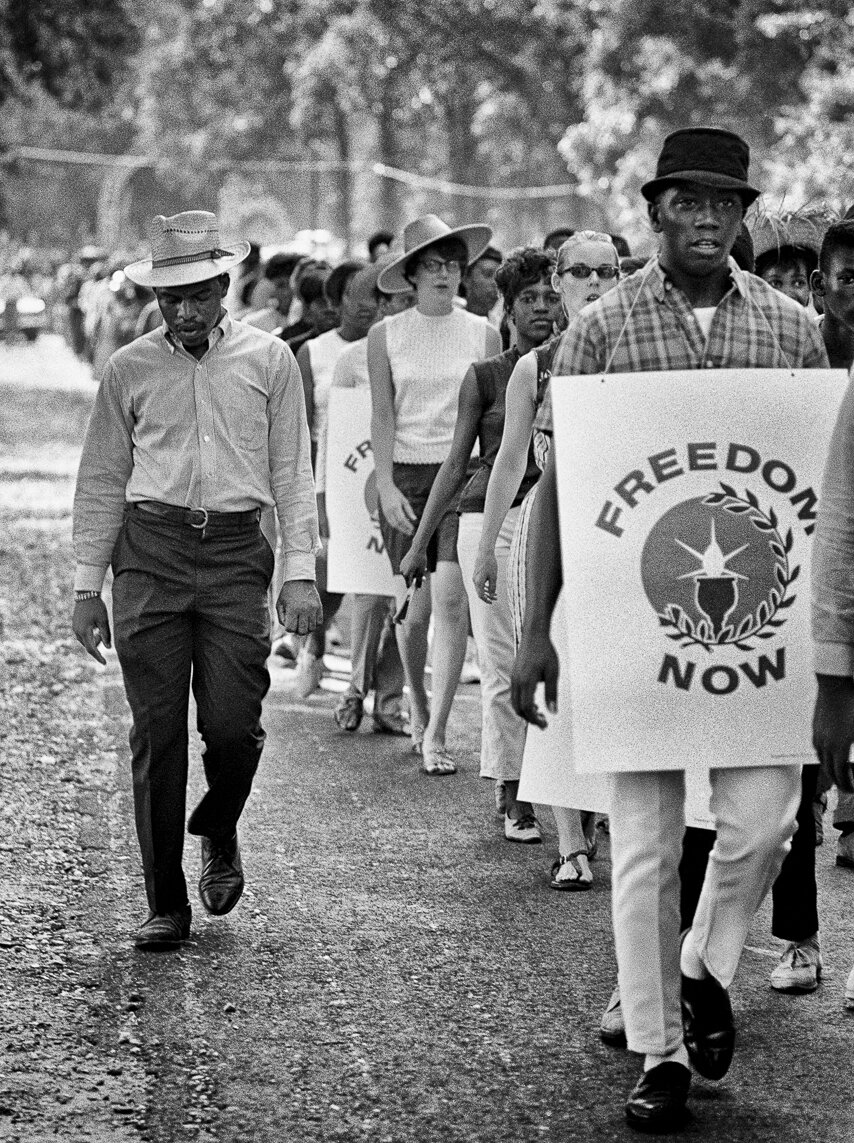
What Do You Know about the Civil Rights Movement?

A Bone-Weary John Lewis Arrives at Tugaloo College on the Outskirts of Jackson, by Maria Varela. Photograph via Webspinner.

The movement included people from different races, ethnicities, religions, and nationalities who joined together to protest inequities for African Americans.
"Injustice anywhere is a threat to justice everywhere. We are caught in an inescapable network of mutuality, tied in a single garment of destiny. Whatever affects one directly, affects all indirectly." - Martin Luther King Jr.

True


What Do You Know about the Civil Rights Movement?


Non-violence was a deliberate tactic employed by protesters during the civil rights movement.
"We adopt the means of non-violence because our end is a community at peace with itself."
- Martin Luther King Jr.

True


A. Voting rights
B. Equal use of public spaces
C. Integration of schools
D. Equal opportunities/pay
E. All of the above
What Do You Know about the Civil Rights Movement?


A. Voting Rights
B. Equal use of public spaces
C. Integration of schools
D. Equal opportunities/jobs & salary

E. All of the above


Throughout this lesson, think about how you might feel if you were denied your civil rights.
What Are Civil Rights?

A White Youth and a Negro Student Picket at the f.w. Woolworth in Greensboro, North Carolina, April 20, 1960, Associated Press. New York World-Telegraph, courtesy of Library of Congress Prints and Photographs Division.


The rights of citizens to political and social freedom and equality, including the right to:
-
Vote
-
Equal public education
-
Fair trial
-
Equal access to public facilities
-
Equal access to government services
What Are Civil Rights?



What Are Civil Rights?

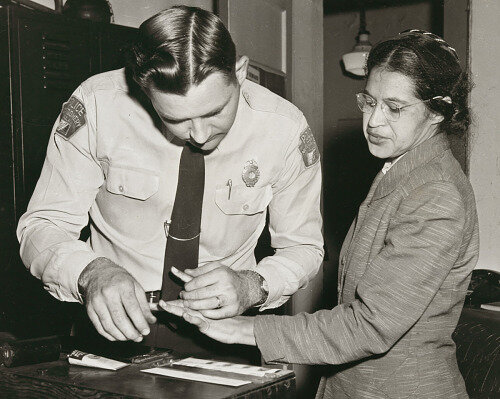
What civil rights were denied to Rosa Parks?
Think back to the breaking news about the Montgomery Bus Boycott...
Rosa Park's Mugshot, Montgomery County Sheriff's Department.
Rosa Parks Being Fingerprinted by Deputy Sheriff D.H. Lackey, photo by Gene Herrick. National Portrait Gallery.
Breaking News!!
Breaking News!!
Breaking News!!


Discussion: "You Better Leave Segregation Alone"
Listen again to the song you heard the protestors singing during the segment:
Breaking News!
What do you think this song is about, and why?


Discussion: "You Better Leave Segregation Alone"
You betta leave segregation alone,
Because they love segregation like a hound dog loves a bone.
I went down to the dime store to get myself some eats,
Well they put me in the jail, and I sat at them folks' seats.
You betta leave segregation alone.
Here is an excerpt from the lyrics:


Discussion: "You Better Leave Segregation Alone"
Thinking about the song lyrics, let's discuss the following questions:


Discussion: "You Better Leave Segregation Alone"
Segregation is a set of laws and customs that separates African Americans from white people in many civic areas of everyday life:
- African American students were not allowed to attend the same schools as white students.
- African Americans drank from separate water fountains, sat at the back of the bus, and entered restaurants, theaters, and other facilities through specially-marked entrances.
Back


Discussion: "You Better Leave Segregation Alone"
Who are the "they" in the lyrics?
Back
The people who want segregation to be left alone are those who promote segregation and the Jim Crow laws. They do not believe that African American citizens deserve the same civil rights as other Americans.


Discussion: "You Better Leave Segregation Alone"
Back
The legal blocking of African Americans from civil rights, including access to housing, public facilities, voting, education, and equal pay for quality jobs is often referred to as "Jim Crow Laws."
Jim Crow laws allowed businesses including dime stores and luncheon counters in both the south and the north to prohibit African Americans from entering them. African American customers had to enter through back doors and take their food outside the store/restaurant to eat.


Discussion: "You Better Leave Segregation Alone"
Does this song sound like a protest song?
Why or why not?


Discussion: "You Better Leave Segregation Alone"
This song was recorded by the Nashville Quartet, a rhythm and blues quartet from Nashville, Tennessee.

Sing for Freedom, cover design by Nancy Jean Anderson. Smithsonian Folkways Recordings.
William Edward John (1937-1968) was better known by his stage name Little Willie John, American rhythm and blues singer.
You were asked earlier to imagine how the top hits of the 1950s might sound . . .
Listen to the 50s hit song "You'd Better Leave My Kitten Alone," first written and recorded in the 1950s by Little Willie Johns, an R & B singer.
What resemblance does it bear to "You Better Leave Segregation Alone" ?



Photo by Michael Ochs, 1955.
Discussion: "You Better Leave Segregation Alone"
Why do you think a protest group adapted popular songs to sing about segregation?


Discussion: "You Better Leave Segregation Alone"
Popular songs were often changed to protest songs because that made them easy to learn: same melody, same rhythm, new words!


Discussion: "You Better Leave Segregation Alone"


Discussion: "You Better Leave Segregation Alone"
After hearing the song and learning about the lyrical content, imagine again that it is 1955. You are the same age and still live in the same town as you do now . . .
How would you react to the song "You Better Leave Segregation Alone" now that you know its relationship to the civil rights movement?


Learning Checkpoint
- What was the purpose of the civil rights movement?
End of Path 1: Where will you go next?




Protest Songs
Path 2

20+ minutes


Protest Songs

Demonstrators Carry a Banner Reading “We March with Selma!” in the Harlem Section of New York City, March 1965, by Stanley Wolfson. Library of Congress.

In 1965, protestors (600+) across the US gathered to march from Selma to Montgomery, Alabama: 54 miles.
One song they most likely sang while marching is "We Shall Overcome" (often called the theme song for the civil rights movement).

"We Shall Overcome"


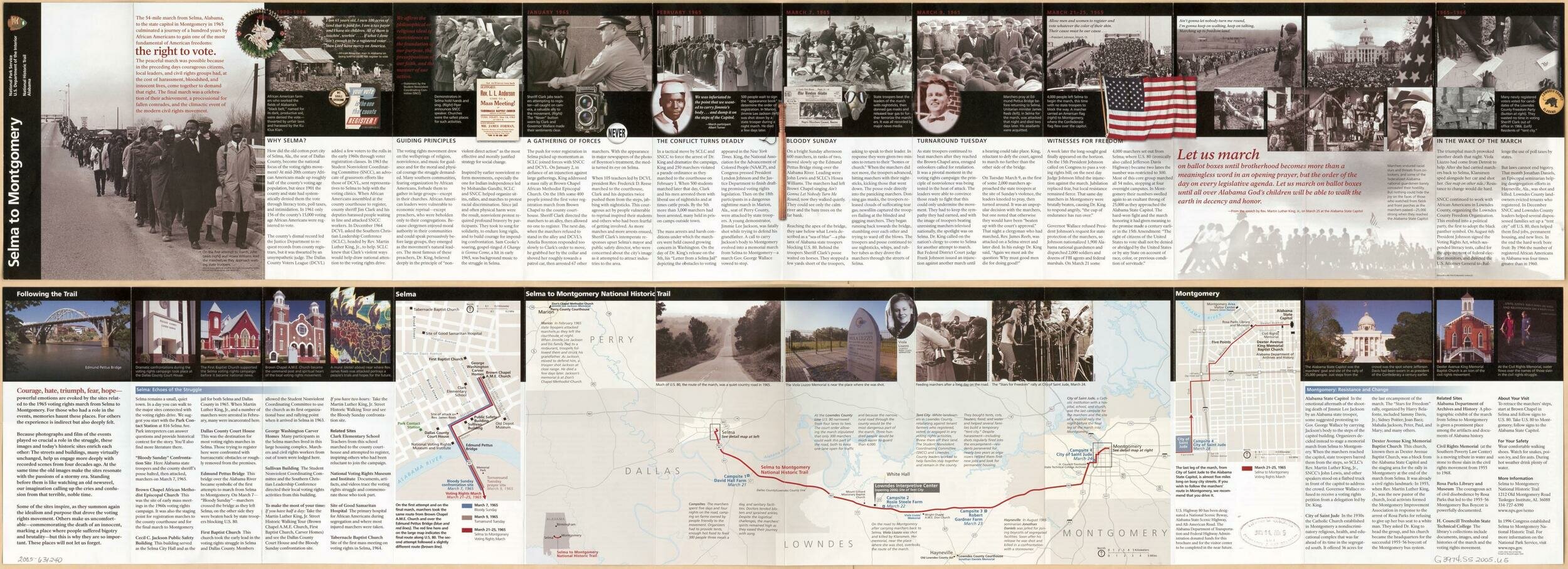
Selma to Montgomery National Historic Trail, Alabama, map created by the National Park Service. Courtesy of Library of Congress.

"We Shall Overcome"


Listen to "We Shall Overcome" by workers in Selma for Jimmie Lee
Use the Listening Log Template to write down all that you hear (instruments, time, pitch, and structure).


"We Shall Overcome": Texture and Form

Listen to several short musical excerpts from the same recording, focusing on the following questions:
How would you describe the texture of the song?
How would you describe the form (structure) of the song?

"We Shall Overcome": Texture

The texture is homophonic:
the melody is prominent while the other voices offer harmonic accompaniment.
Monophonic: a single melodic line without accompaniment
Polyphonic: multiple, independent melodic voices
Heterophonic: two or more voices performing variations of the same melody

"We Shall Overcome": Form

The structure is strophic:
all verses are sung to the same music.
In through-composed music,
each verse is sung to different music.

"We Shall Overcome": Texture and Form


Freedom Songs: Selma, Alabama, cover art by Ronald Clyne. Folkways Records
Why are form and texture important features in a protest song?


How do you think protestors usually learned this type of music?...
Consider its form of "transmission"
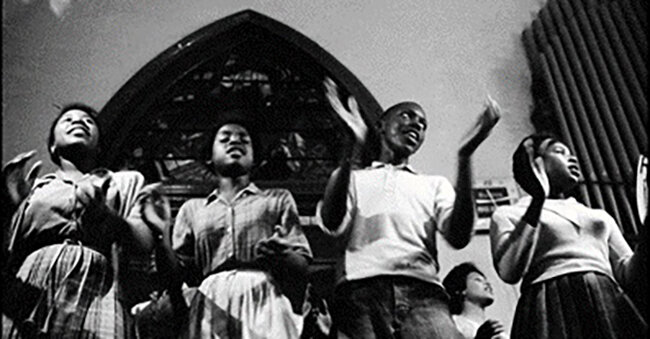
The Freedom Choir, photo by Danny Lyon. Beacon Broadside.
"We Shall Overcome": Transmission


Oral culture refers to what is spoken and sung; aural culture refers to what is heard and comprehended...

Oral/Aural Transmission

"We Shall Overcome" is one of the most famous protest songs from the civil rights movement. But it did not begin that way.
Oral/Aural Transmission

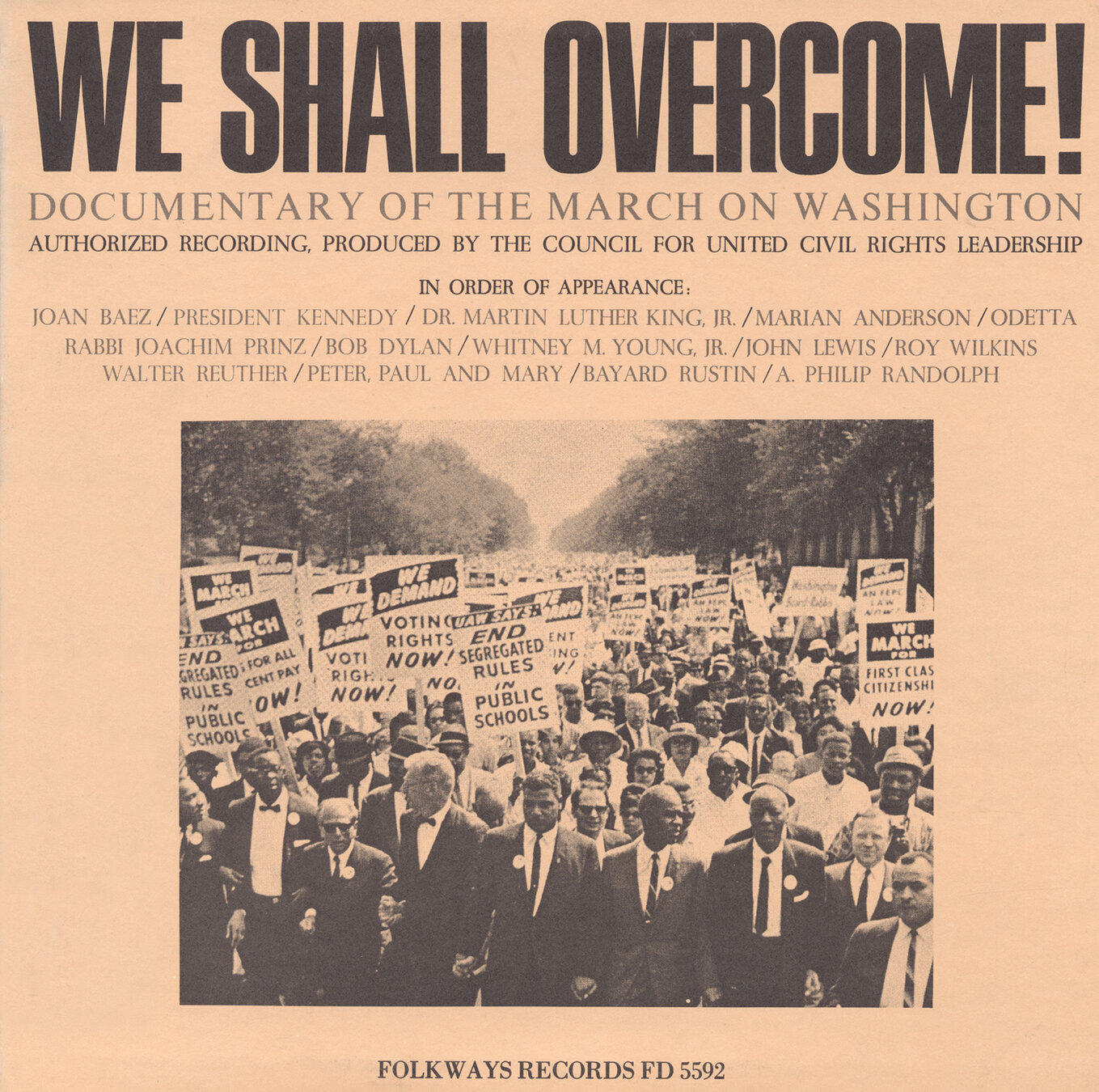
It has been performed and arranged by many artists, some changing the lyrics and others the melody.
CAPTION NEEDED

The song originated as a gospel hymn believed to be written and published by Charles Albert Tindley in the early 20th century.
Its original title was "I'll Overcome Someday."
Oral/Aural Transmission




We shall overcome, my Lord,
We shall overcome, my Lord. We shall overcome some day.
We shall live in peace;
We shall live in peace.
We shall live in peace some day.
We are not afraid;
We are not afraid.
We are not afraid today.
God is on our side;
God is on our side.
God is on our side today.
Oh, deep in my heart,
I do believe,
We shall overcome some day.
We shall overcome;
We shall overcome,
We shall overcome some day.
Review some common lyrics to
"We Shall Overcome."
Oral/Aural Transmission



Listen to "We Shall Overcome" by workers in Selma for Jimmie Lee
Use the Listening Log Template to write down all that you hear (instruments, time, pitch, and structure).

Oral/Aural Transmission: "We Shall Overcome"

Listen to an excerpt from another version of "We Shall Overcome" performed by Joan Baez at the 1963 March on Washington.
Oral/Aural Transmission


How is this musical example the same and/or different from the version we heard earlier?
Civil Rights March on Washington, D.C. [Entertainment: Vocalist Joan Baez. A sign hanging near the microphones reads "We Shall Overcome." ] by U.S. Information Agency. Press and Publications Service. (ca. 1953 - ca. 1978), Rowland Scherman, Public Domain. National Archives of College Park.

Oral/Aural Transmission

Similarities:
Meter (4/4)
Unison
Strophic (AAA)
Lyrics
Differences:
Vocal vs Guitar
Lack of interjection
Tempo
Lining out


Aesthetics of Black music performance

Aesthetics of Black Music Performance

Ethnomusicologist Melonnee Burnim identifies three "areas of aesthetic significance" that influenced African American music making:
1. Sound quality (timbre)
2. Delivery (time, text, pitch)
3. Style of delivery
These are all influenced by West and Central African music.

Discussion:
Why are some musical elements more important in the context of protest songs?
Which musical elements are important when organizing a protest?
How might musical style play an important role in the performance of a protest song?


Learning Checkpoint
- Protestors often use what form of transmission when learning and teaching protest songs to others?

End of Path 2: Where will you go next?




Arranging
"We Shall Overcome"
Path 3

30+ minutes


"We Shall Overcome" has numerous arrangements.
Let's listen to some excerpts.
Arranging "We Shall Overcome"

Performed by Pete Seeger
Performed by Joe Glazer
Performed by the Child Development Group of Mississippi

Screenshot from Search Engine of “We Shall Overcome,” Smithsonian Folkways Recordings.
Arranging "We Shall Overcome"

Use a Venn diagram to chart some differences you noticed between the examples shared.


CDG
Pete
Joe
What do they have in common?
Arranging "We Shall Overcome"

Option 1:
As you create your own arrangement of "We Shall Overcome," consider:

Arranging the chorus only:
We shall overcome;
We shall overcome
We shall overcome some day
Oh deep in my heart, I do believe,
We shall overcome some day.
Choose one element to alter:
meter tempo rhythm
harmony timbre form
Arranging "We Shall Overcome"


Option 2:
Create your own protest song.
An aural hallmark of the civil rights movement was its ability to repurpose popular music to rally attention to a cause. Think of a song that you love and know well . . .
- Write down the words to the chorus.
- Choose a topic that interests you, e.g., climate change, DACA, LGBTQIA Rights, Black Lives Matter, etc...
- Rewrite the lyrics of the chorus to address your topic, considering the structure, meter and rhythm.
- Share your lyrics with the class.

Learning Checkpoint
- Protest songs often draw from what genre or style of music?
- Why?

End of Path 3 and Lesson Hub 1: Where will you go next?





Lesson 1 Media Credits
Audio courtesy of:
Smithsonian Folkways Recordings
Video courtesy of:
Les Blank Films and Argot Productions
Images courtesy of:
Archives of American Art
The Arhoolie Foundation
Custom Creations
David Dilts
National Museum of African American History and Culture
National Museum of American History
National Portrait Gallery
Smithsonian American Art Museum
Smithsonian Folkways Recordings
TM/© 2021 the Cesar Chavez Foundation. www.chavezfoundation.org
© 2023 Smithsonian Institution. Personal, educational, and non-commercial uses allowed; commercial rights reserved. See Smithsonian terms of use for more information
This Lesson was funded in part by the Smithsonian Youth Access Grants Program with support from the Society for Ethnomusicology and the National Association for Music Education.
For full bibliography and media credits, see Lesson 1 landing page.

